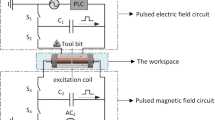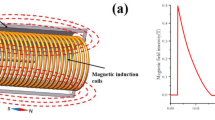Abstract
High-quality and high-efficiency cutting technology for Ti6Al4V has rapidly developed, but is still limited by many problems such as high cutting temperature and fast tool wear during the machining process. To improve the machining performance and service life of cemented carbide cutting tools, an electromagnetic treatment was applied and cutting performances with and without electromagnetic treatment were compared. The influences of electromagnetic treatment on the hardness and thermal properties of cemented carbide tool were tested. The cutting force, cutting temperature, and flank wear during the machining process were recorded and comparatively analyzed. Finite element simulation was carried out to further evaluate temperature performance of the cutting tool during machining. The experimental results showed that after electromagnetically treatment, the service life of the tool at a cutting speed of 80 m/min and feed rate of 0.15 mm/r was increased by 133%. The results revealed that electromagnetic treatment can improve the cutting performance and efficiency of cemented carbide tools for Ti6Al4V machining. The electromagnetic treatment-induced performance improvements are discussed on the basis of the experimental and simulation results, which imply potential benefits of electromagnetic treatment in the field of cutting tools, particularly the decrease in hardness deviation and increase of coating adhesion. These benefits together with the significant enhancement of too life demonstrated the feasibility of improvement of cutting tools by using electromagnetic treatment.














Similar content being viewed by others
Availability of data and material
All data generated or analyzed during this study are included in this published article.
Code availability
Not applicable.
References
Pramanik A (2014) Problems and solutions in machining of titanium alloys. Int J Adv Manuf Tech 70(5-8):919–928. https://doi.org/10.1007/s00170-013-5326-x
Oosthuizen GA, Akdogan G, Treurnicht N (2011) The performance of PCD tools in high-speed milling of Ti6Al4V. Int J Adv Manuf Tech 52(9-12):929–935. https://doi.org/10.1007/s00170-010-2804-2
Zhu F-H, Xiong W, Li X-F, Chen J (2018) A new flow stress model based on Arrhenius equation to track hardening and softening behaviors of Ti6Al4V alloy. Rare Metals 37(12):1035–1045. https://doi.org/10.1007/s12598-017-0979-5
Zheng H-D, Liu L-L, Deng C-L, Shi Z-F, Ning C-Y (2019) Mechanical properties of AM Ti6Al4V porous scaffolds with various cell structures. Rare Metals 38(6):561–570. https://doi.org/10.1007/s12598-019-01231-4
Saketi S, Odelros S, Ostby J, Olsson M (2019) Experimental study of wear mechanisms of cemented carbide in the turning of Ti6Al4V. Materials 12(17). https://doi.org/10.3390/ma12172822
Umbrello D (2008) Finite element simulation of conventional and high speed machining of Ti6Al4V alloy. Journal of Materials Processing Technology 196(1-3):79–87. https://doi.org/10.1016/j.jmatprotec.2007.05.007
Sun S, Brandt M, Dargusch MS (2009) Characteristics of cutting forces and chip formation in machining of titanium alloys. Int J Mach Tools Manuf 49(7-8):561–568. https://doi.org/10.1016/j.ijmachtools.2009.02.008
Mishra SK, Ghosh S, Aravindan S (2019) Performance of laser processed carbide tools for machining of Ti6Al4V alloys: a combined study on experimental and finite element analysis. Precision Engineering-Journal of the International Societies for Precision Engineering and Nanotechnology 56:370–385. https://doi.org/10.1016/j.precisioneng.2019.01.006
Babu B, Lindgren LE (2013) Dislocation density based model for plastic deformation and globularization of Ti-6Al-4V. Int J Plast 50:94–108. https://doi.org/10.1016/j.ijplas.2013.04.003
Wang ZH, Yu B, Liu K, Yin ZB, Yuan JT, Zhu YP (2020) Performance and wear mechanism of spark plasma sintered WC-based ultrafine cemented carbides tools in dry turning of Ti-6Al-4V. Ceram Int 46(12):20207–20214. https://doi.org/10.1016/j.ceramint.2020.05.101
Wei L, Yang Y, Yang G, Wu M, Wei C, Wu X (2019) Effect of electromagnetic compound treatment on microstructure and performance of cemented carbide. Journal of Wuhan University of Technology-Materials Science Edition 34(5):1119–1126. https://doi.org/10.1007/s11595-019-2168-x
Yihang F, Minli Z, Zhe L, Songtao W, Yingbin L (2012) Cutting performance of cemented carbide tool in high-efficiency turning Ti6AI4V. Key Engineering Materials 522:231–235. https://doi.org/10.4028/www.scientific.net/KEM.522.231
Wang Y, Su HH, Dai JB, Yang SB (2019) A novel finite element method for the wear analysis of cemented carbide tool during high speed cutting Ti6Al4V process. Int J Adv Manuf Tech 103(5-8):2795–2807. https://doi.org/10.1007/s00170-019-03776-1
Chandrashekar M, Prasad KVS (2018) The effect of cobalt on wear behavior of cemented carbide cutting tools for machining of titanium alloy. Materials Today-Proceedings 5(2):7678–7684
Zha XM, Chen FB, Jiang F, Xu XP (2019) Correlation of the fatigue impact resistance of bilayer and nanolayered PVD coatings with their cutting performance in machining Ti-6Al-4V. Ceram Int 45(12):14704–14717. https://doi.org/10.1016/j.ceramint.2019.04.193
Ambigai R, Prabhu S, Gandhi R (2020) Taguchi based optimization of coated and uncoated tool insert for turning Ti6Al4V using grey relation analysis. IOP Conference Series: Materials Science and Engineering 912:032048 (032012 pp.)-032048 (032012 pp.). https://doi.org/10.1088/1757-899x/912/3/032048
Matei AA, Pencea I, Stanciu SG, Hristu R, Antoniac I, Ciovica E, Sfat CE, Stanciu GA (2015) Structural characterization and adhesion appraisal of TiN and TiCN coatings deposited by CAE-PVD technique on a new carbide composite cutting tool. Journal of Adhesion Science and Technology 29(23):2576–2589. https://doi.org/10.1080/01694243.2015.1075857
Chowdhury MSI, Bose B, Yamamoto K, Shuster LS, Paiva J, Fox-Rabinovich GS, Veldhuis SC (2020) Wear performance investigation of PVD coated and uncoated carbide tools during high-speed machining of TiAl6V4 aerospace alloy. Wear 446:8. https://doi.org/10.1016/j.wear.2019.203168
Caliskan H, Altas E, Panjan P (2017) Study of nanolayer AlTiN/TiN coating deposition on cemented carbide and its performance as a cutting tool. Journal of Nano Research 47:1–10. https://doi.org/10.4028/www.scientific.net/JNanoR.47.1
Liu J, Wei C, Yang G, Wang L, Wang L, Wu X, Jiang K, Yang Y (2018) A novel combined electromagnetic treatment on cemented carbides for improved milling and mechanical performances. Metallurgical and Materials Transactions a-Physical Metallurgy and Materials Science 49A(10):4798–4808. https://doi.org/10.1007/s11661-018-4740-y
Shao Q, Kang JJ, Xing ZG, Wang HD, Huang YF, Ma GZ, Liu HP (2019) Effect of pulsed magnetic field treatment on the residual stress of 20Cr2Ni4A steel. J Magn Magn Mater 476:218–224. https://doi.org/10.1016/j.jmmm.2018.12.105
Antolovich SD, Conrad H (2004) The effects of electric currents and fields on deformation in metals, ceramics, and ionic materials: an interpretive survey. Materials and Manufacturing Processes 19(4):587–610. https://doi.org/10.1081/AMP-200028070
Cao FR (2017) Electron wind stress model and calculation examples under pulse current. Advances in Condensed Matter Physics 006 (001):P.1-5
Paulmier D, Zaidi H, Bedri R, Kadiri EK, Pan L, Jiang Q (1995) Steel surface modifications in magnetised sliding contact. Surface & Coatings Technology 76-77(1-3):583–588. https://doi.org/10.1016/0257-8972(95)02607-x
Bagchi P, Ghosh A (1971) Mechanism of cutting-tool wear in the presence of a magnetic field. INDIAN J TECHNOL 9(5):165–169
Cai ZP, Huang XQ (2011) Residual stress reduction by combined treatment of pulsed magnetic field and pulsed current. Mater Sci Eng A-Struct Mater Prop Microstruct Process 528(19-20):6287–6292. https://doi.org/10.1016/j.msea.2011.04.078
Hou M, Li K, Li X, Zhang X, Rui S, Wu Y, Cai Z (2020) Effects of pulsed magnetic fields of different intensities on dislocation density, residual stress, and hardness of Cr4Mo4V steel. Crystals 10(2). https://doi.org/10.3390/cryst10020115
El Rassy E, Billaud Y, Saury D (2020) Flash method experiment design for the thermal characterization of orthotropic materials. Meas Sci Technol 31(8):15. https://doi.org/10.1088/1361-6501/ab7f78
Xiong M, Feng Y, Feng D, Zhang X, Wang G (2018) Thermal properties of metal organic frameworks composite with phase change. Journal of Engineering Thermophysics v. 39(01):165–171
Roscioli G, Taheri-Mousavi SM, Tasan CC (2020) How hair deforms steel. Science 369 (6504):689-+. https://doi.org/10.1126/science.aba9490
Xu J, Deng Y, Wang C, Liang G (2021) Numerical model of unidirectional CFRP in machining: development of an amended friction model. Composite Structures 256:113075. https://doi.org/10.1016/j.compstruct.2020.113075
Xi Y, Bermingham M, Wang G, Dargusch M (2013) Finite element modeling of cutting force and chip formation during thermally assisted machining of Ti6Al4V alloy. J Manuf Sci Eng-Trans ASME 135(6):9. https://doi.org/10.1115/1.4025740
Kay G (2002) Failure modeling of titanium-6Al-4V and 2024-T3 aluminum with the Johnson-Cook material model. Lawrence Livermore National Laboratory, United States. https://doi.org/10.2172/15006359
Chen P, Tong J, Zhao J, Zhang Z, Zhao B (2020) A study of the surface microstructure and tool wear of titanium alloys after ultrasonic longitudinal-torsional milling. Journal of Manufacturing Processes 53:1–11. https://doi.org/10.1016/j.jmapro.2020.01.040
Acknowledgements
We thank Kathryn Sole, PhD, from Liwen Bianji, Edanz Group China (www.liwenbianji.cn/ac), for editing the English text of a draft of this manuscript.
Funding
This work was supported by the Key National Science and Technology Projects of China under Grant No. 2018ZX04042001, the National Natural Science Foundation of China under Grant No. 51705281, and Shenzhen Foundational Research Project (Discipline Layout) under Grant No. JCYJ20180508152128308.
Author information
Authors and Affiliations
Contributions
Wenmeng Zhou, Jiachen Lin, and Feng Feng carried out the research and wrote the original manuscript. Yuan Ma, Huiting Zha, Enlai Jiang, and Wen Ji assisted with conceptualization of the investigation. Zhipeng Cai and Pingfa Feng assisted with the data analysis and manuscript editing. All authors have read and agreed to the published version of the manuscript.
Corresponding authors
Ethics declarations
Conflict of interest
The authors declare that they have no affiliations or involvement with organizations that have financial interests in the subject matter or materials discussed in this paper.
Additional information
Publisher’s note
Springer Nature remains neutral with regard to jurisdictional claims in published maps and institutional affiliations.
Rights and permissions
About this article
Cite this article
Zhou, W., Lin, J., Feng, F. et al. Performance improvement of carbide cutting tool for Ti6Al4V alloys using electromagnetic treatment. Int J Adv Manuf Technol 113, 1547–1560 (2021). https://doi.org/10.1007/s00170-021-06691-6
Received:
Accepted:
Published:
Issue Date:
DOI: https://doi.org/10.1007/s00170-021-06691-6




